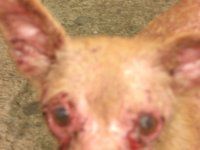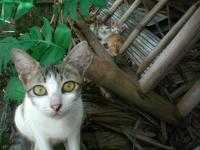Why Feed Natural Homemade Pet Food
Sponsored Links
If you do what you've always done, you get what you've always got
— Dov Baron
Homemade pet food or any type of food you feed your dog or cat should be nothing more than a simulation of what they would get in the wild. What a concept, huh? And no, dry food is not natural.
Now I know what you are thinking...
You are thinking
but dogs and cats are no longer wild, they are domesticated.
This is true, but domestication has not changed their constitution.
So let's really look at how similar our domesticated pets are to their wild cousins. Let's become aware of these similarities — because if the theory that domestication has changed our pets is true — then why, why are our pets so similar still to their wild cousins — and why do they still exhibit similar physical and psychological traits to their wild cousins?
The Dog Whisperer, Cesar Millan, has clearly illustrated how our domesticated dogs today still have the same pack mentality as their wild cousins.
Now here's where the fun really begins!
In The Raw
 Evolutionary changes can takes thousands of years and although our pets have been domesticated for a while now, commercial pet food and terribly unnatural diets are relatively new.
Evolutionary changes can takes thousands of years and although our pets have been domesticated for a while now, commercial pet food and terribly unnatural diets are relatively new.
Even if one goes back 50 or 100 years, one would see that many dogs were at least fed table scraps, raw meat, etc, and in some cases the cat (or dog) would hunt for additional food. Of course, many cats (and some dogs) still hunt (or at least try).
Dogs and cats still come into heat the way their ancestors did. Their canines are still larger than their incisors. Large canines are used for ripping meat from the prey, puncturing the arteries in the neck, suffocating prey and well, to literally kill the prey. On the other hand, we have a rabbit whose incisors constantly keep growing for gnawing on foods. What a difference huh?
 Lions are known to have purrfectly white (never dirty) 50 millimeter fangs, a leopard's are about 32 millimeters and a cheetah's are about 25 millimeters. According to Jack Hanna, host of the TV show
Lions are known to have purrfectly white (never dirty) 50 millimeter fangs, a leopard's are about 32 millimeters and a cheetah's are about 25 millimeters. According to Jack Hanna, host of the TV show Animal Adventures
, the extremely rare, but incredibly beautiful clouded leopard of Asia has the largest fangs at over 50 millimeters (2 inches). That's ridiculously huge when you think about it (yikes).
Our pet's sense of smell is still 1000 times more powerful than a human's even though most dog and cats no longer hunt for food based on their sense of smell. In fact, dogs are born with their nose open, their eyes open in about a week or so followed by their ears. Truly, even today, the sense of smell is a valuable tool for our pets and has not diminished even though they have been domesticated.
We all know dogs are used for finding narcotics because of their keen sense of smell and if you go away for a few months and then return home, the first thing you pet will do is smell you. Your body odor
is like aroma identification!
A dog's neck muscles are still their strongest muscle for ripping and tearing the meat off their prey.
The dog's jaw still goes up and down rather than side to side. Plus a dog's jaw can open really wide so they eat and swallow large chunks of meat, or should I saw inhale and gulp chunks of meat. This leads to the next point.
The dog or cat will still eat as much food as fast as they can because in the wild they never know if a relative or a competitor higher up on the chain will come along and tell them to get lost. As a result, a dog or cat can still be, shall we say, overly protective of their food.
The stomach of our carnivore friends is still approximately 65% of their digestive system while their intestinal tract is about 35%. This is in stark contrast to a herbivore, such as a goat, cow or horse whose stomach is approximately 15% of their digestive system while their intestinal tract is about 85%. This is why a herbivore is constantly grazing. The herbivore eats small amounts which quickly pass through their small stomach. The vegetation then enters the intestinal tract of the herbivore where it spends quite a bit of time being broken down because, believe it or not, but vegetation takes longer to digest than meat. On the other paw the carnivore, with their extra large stomach, will eat one massively huge meal then sit back and relax while the food is being digested. Once the meat hits the intestinal tract of the carnivore it passes through the body really quick before any putrefaction can happen. If a herbivore were to eat meat, then the meat would be stuck in their intestinal tract too long leading to the meat beginning to putrefy. Conversely, if a carnivore were to eat whole vegetation, then the vegetation would simply pass right through the body without being broken down because not only does the carnivore not have the correct type of teeth to grind the vegetation down, but the intestinal tract is just too short to digest the food. Fascinating. Really, when you think about it, Mother Nature has created each animal to work perfectly for the food that is best for them.
 The digestive system of a dog or cat is still about the same as their wild cousins and a dog or cat's jaw still only goes up and down for maximum ripping power unlike a horse's jaw which moves sideways for maximum chewing and grinding.
The digestive system of a dog or cat is still about the same as their wild cousins and a dog or cat's jaw still only goes up and down for maximum ripping power unlike a horse's jaw which moves sideways for maximum chewing and grinding.
Cats still have the tendency to chew with their molars. The cat's molars were designed to cut through meat, tendons, ligaments and more!
This feline habit of chewing with molars is most easily noticed if you feed a chunk of meat to your cat. Next time you see a lion or any feline on TV eating its prey, watch for this habit. Dogs, well what can I say except open the mouth and pass the gums, look out stomach, here it comes. Dogs swallow whole after ripping off a piece of meat.
Many cats walk just like their distant cousin, the leopard. The leopard who hunts mostly on stealth is known to be able to place its back foot in the exact foot print of its front foot to minimize noise.
Cats are also known to play with the food they catch. This similar behavior is also common among the elusive ocelot of the Amazon.
Like the puma, who hunts on stealth and who has been known to jump 30 feet, cats still have incredible jumping ability because of powerful hind legs. In addition, most cats still do not like water too much, although there are a few exceptions to this rule including the marvelous jaguar. The jaguar, whose name is a native word for he who attacks but once
, has been known to take a dip now and then.
Even though dogs and cats no longer need to hunt, many dogs and cats still have black hair around their eyes if they were originally a day hunter. The black hair is Mother Nature's way of eliminating glare. If the dog or cat was originally created to hunt at night, the hair around the eye will be a light colour to attract the most amount of light for exceptional night sight. Look for this feature! You will see it on a lion or any other carnivore including your pet!
On pages 21 to 23 of Dr. Kirk's Current Veterinary Therapy for Small Animals - Volume X, he basically notes that cats (and dogs) still prefer their food served warm at approximately 78 to 103 degrees Fahrenheit (25.6 to 39.4 degrees Celsius which is the approximate temperature of fresh prey). Other characteristics of their eating habits include their preference for infrequent meals that have a high water, protein, and fat content. The dog or cat is still said to rely heavily on their sense of smell in the selection of foods.
Like their feline cousins, our cats are still careful about getting their whiskers wet or dirty while drinking from a bowl or eating their food. African wild dogs, coyotes, wolves and our dogs, well, they couldn't care less about their whiskers, they just want the food. As far as dogs are concerned, sofas and couches were invented for cleaning their whiskers after eating!
Taking all of this into account, as you will see in Part 3 of this book (how to make natural homemade pet food), we feed meats with normal fat content and hot water is sometimes added to the food to volatize the odour, make it moist and make it warm since cold food also shuts down the digestive system. All of this helps to recreate and simulate the warmth, moisture, smell and taste of a fresh kill.
For those with cats, you may find it advantageous to feed your cat's food in a shallow but wide bowl so your cat's whiskers won't get dirty. Those people with dogs will most likely find it is advantageous to feed the food (a bowl is optional).
Domestication may have changed the loyalty of the dog or cat, but it has not changed their general constitution and in some cases their behavior has not changed either.
We all know dogs still bury bones and dig them up two weeks later and eat them rotten with no problem. Dogs still scratch the ground after urinating or defecating, not to hide their mess (because let's face it, they're never on target anyway). No, dogs scratch the ground because they have scent glands on their feet.
There was a PBS show on cats showing how the regular domesticated cat does just about everything that the King of the Jungle (the lion) does. This includes male cats even killing kittens that are not of their genes.
Dogs still make their bed before sleeping! Yeah, have you ever noticed how a dog will walk in circles before laying down for a rest? Now why would a dog do this? Simple, because in the wild, a dog needs to make the grass, especially tall grass, lay flat before it can lay down comfortably. Isn't it interesting how a domesticated dog still exhibits this wild
behaviour even though the domesticated dog doesn't sleep in tall grass anymore!
Female cats will still lick their kittens during hot weather just as a female cheetah does in Africa — why? Because as the saliva (moisture) on the fur is brushed by a gentle breeze, it acts as a natural hot weather coolant.
You know, I'm not kidding when I say homemade food is just common sense and that's all.
Great Start, But There's Still More
I hope by now you are excited and wanting to learn more:
- Why Feed Natural Homemade Pet Food?
- Let's Take A Closer Look A Natural Homemade Pet Food
- An Early Conclusion About Natural Homemade Pet Food
- Feeding — How Much To Feed Dogs and Cats
- Water — Pets Drink Water While Eating
- The Importance of Calcium
- How To Make Your Own Calcium Supplement
- Pet Supplements — A Quick Introduction
- The Benefits of Enzymes
- Nutritive Herbs
 Meet Jumbo, the participant in
Meet Jumbo, the participant in 